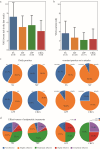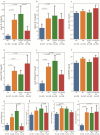Characterization of cells and mediators associated with pruritus in primary cutaneous T-cell lymphomas
- PMID: 39068637
- PMCID: PMC11284195
- DOI: 10.1007/s10238-024-01407-y
Characterization of cells and mediators associated with pruritus in primary cutaneous T-cell lymphomas
Abstract
Patients with primary cutaneous T-cell lymphoma (CTCL) often experience severe and difficult-to-treat pruritus that negatively affects their quality of life (QoL). However, the mechanisms of pruritus in CTCL, including mycosis fungoides (MF), remain largely unknown, and detailed characteristics of CTCL-associated pruritus is not fully elucidated. To characterize pruritus in CTCL, cutaneous B-cell lymphoma (CBCL), and large plaque parapsoriasis (LPP), and to identify potential itch mediators involved in the pathogenesis of pruritus in CTCL patients. Clinical data and blood samples were collected from 129 healthy subjects and 142 patients. Itch intensity, QoL impairment, psychological distress, and sleep quality were assessed using validated questionnaires and instruments. Blood levels of BDNF, CCL24, GRP, IL-31, IL-33, sST2, substance P, TSLP, tryptase and total IgE were measured using ELISA or ImmunoCAP. Pruritus was prevalent in CTCL, LPP and CBCL patients, with higher prevalence and severity observed in CTCL. In CTCL, pruritus correlated with significant impairment in QoL, sleep, psychological distress. Compared to healthy controls, elevated levels of IL-31, IL-33, substance P, total IgE, tryptase, and TSLP were found in MF patients. A comparison of MF patients with and without pruritus revealed higher levels of IL-31, substance P, GRP, and CCL24 in the former. Itch intensity positively correlated with IL-31, GRP, CCL24, and tryptase levels. Pruritus significantly burdens CTCL patients, necessitating appropriate therapeutic management. Our findings suggest that various non-histaminergic mediators such as tryptase and IL-31 could be explored as novel therapeutic targets for managing pruritus in MF patients.
Keywords: Cutaneous T-cell lymphoma; IL-31; Mast cells; Mycosis fungoides; Pruritus; Tryptase.
© 2024. The Author(s).
Conflict of interest statement
MMa has no conflict of interest within the present work. Outside of it, MMa is or recently was a speaker and/or advisor for and/or has received research funding from Allakos, Alvotech, Amgen, Aquestive, Aralez, AstraZeneca, Astria, Bayer, BioCryst, Blueprint, Celldex, Celltrion, Centogene, CSL Behring, Evoemmune, GSK, Ipsen, Kalvista, Kyowa Kirin, Leo Pharma, Lilly, Menarini, Mitsubishi Tanabe Pharma, Moxie, Noucor, Novartis, Orion Biotechnoloy, Pharvaris, Resonance Medicine, Sanofi/Regeneron, Septerna, Takeda, Teva, Trial Form Support International AB, Third HarmonicBio, Valenza Bio, Yuhan Corporation, and Zurabio. MMe has no conflict of interest within the present work. Outside of it, MMe is or recently was a speaker and/or advisor for AbbVie, Amgen, AstraZeneca, argenx, Bayer, Beiersdorf, Celldex, Escient, Galderma, gsk, Incyte, Jasper, Novartis, Pharvaris, Pfizer, Sanofi-Aventis, Teva, ThirdHarmonicBio, Vifor. MHu, JS, SF, CS, UR, MS, KP, MHa, TH have no conflict of interest to declare.
Figures




References
-
- Trautinger F, Eder J, Assaf C, et al. European Organisation for Research and Treatment of Cancer consensus recommendations for the treatment of mycosis fungoides/Sézary syndrome - Update 2017. Eur J Cancer. 2017;77:57–74. 10.1016/j.ejca.2017.02.027. - PubMed
-
- Raap U, Ständer S, Metz M. Pathophysiology of itch and new treatments. Curr Opin Allergy Clin Immunol. 2011;11(5):420–7. 10.1097/ACI.0b013e32834a41c2. - PubMed
-
- Misery L, Pierre O, Le Gall-Ianotto C, et al. Basic mechanisms of itch. J Allergy Clin Immunol. 2023;152(1):11–23. 10.1016/j.jaci.2023.05.004. - PubMed
MeSH terms
Substances
LinkOut - more resources
Full Text Sources
Medical
Research Materials

